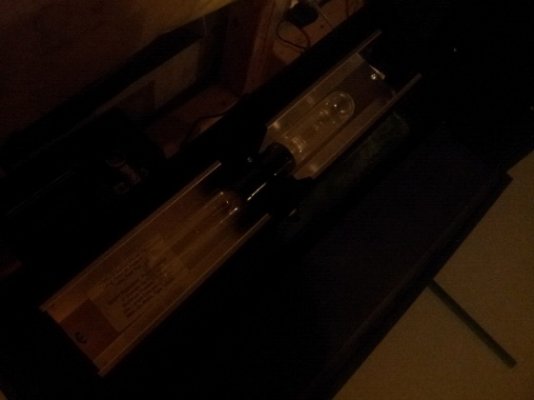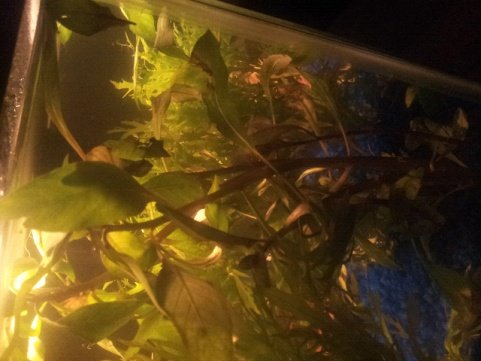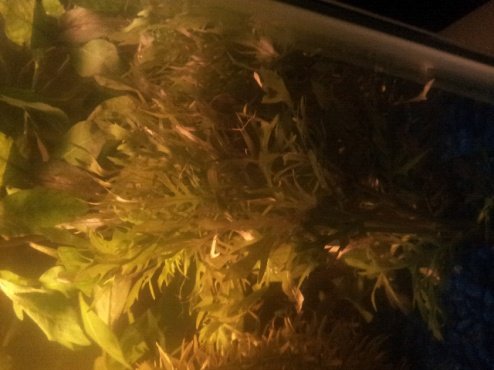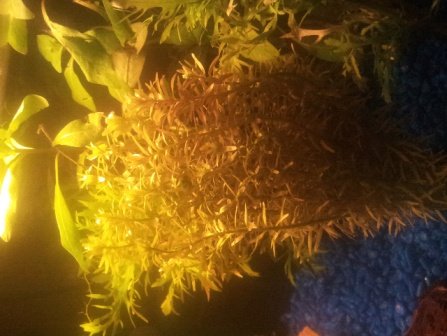So much depends on what plants you have & how you feed them, as well as light levels. Low light plants can get by with little or no feeding beyond what the fish supply with their waste & low light. Tank depth plays a role in the intensity of lighting too. A ten G is very shallow compared to larger tanks, so light penetrates to the bottom much more easily and in greater amounts, so what might be medium or low light on a bigger tank may very well be high light on a tenG or smaller tank.
Plants that grow low and spread, called carpeting plants, for the most part need higher light levels and feeding to grow well, as well as frequent trimming to look nice. The deeper the tank, the more light you need to grow these plants as a carpet, which is a very popular look.
And if you started with low light, once you add a significantly higher amount of light, what you are doing, in essence, is 'driving' the plants to grow faster. But to do that they need more nutrients than fish alone can supply, so you have to fertilize them to have them grow well and look the way they do in the pictures you see online.
You can buy premixed liquid fertilizers, like Flourish Comprehensive, and many other elements, like iron or trace nutrients. Or you can buy dry ingredients, often from a hydroponic supply store and mix them together yourself. There is information on this in many places, such as Tom Barr's Barr Report. There are different strategies for dosing ferts, such as EI, [ estimative index], and others. Which one you choose to follow may depend on how much water testing you are willing to do.
You have to decide how much effort you want to put into the plants. Do you want to do a lot of testing, fertilizing, etc., or not ? Do you want to save money and mix your own ferts or buy them premixed, which is easy but costs a lot more ?
And are you going to be happy with low light plants ? There are a good number that will do well with low light. Or do you want some of the ones with vibrant red colours, for example ? Most of the vividly red plants need much higher lighting levels than their green counterparts and more feeding, though there are exceptions. Some need more iron, but not all & there are some all green ones that are heavy iron feeders and very particular about their conditions. Some plants do much better in acidic soft water, and may not grow in hard, alkaline water, or not grow well.
Root feeders, such as plants with crowns, like swords and crypts, need fert tabs in the substrate to do their best, being heavy feeders. They'll grow much faster with fert tabs than without, and look better, particularly the red sword varieties, which tend to fade away unless well fed.
Also, many plants need CO2 supplementation. Water has next to no carbon in it, but plants all need carbon. Terrestrial plants get theirs from the CO2 in air, and in nature, water plants have many ways to get what they need from their environment.
But in a tank, we have to supply the additional carbon. You can supplement using the so called liquid CO2 products, such as Seachem's Excel, but it is not as good as CO2 from the gas itself. You can supplement the gas using DIY techniques with sugar/yeast bottles, or compressed CO2 gas from a cylinder. Yeast/sugar is lower tech, but over time will eventually cost more, as you continue to buy sugar and yeast. A bottle only lasts until the alcohol level inside it rises high enough to kill the yeast, then you must have another bottle. So you are always making up bottles and changing them out, and there is some risk of yeast getting into the tank if you make a mistake and it can be bad news for the fish or other livestock.
Compressed gas is more expensive to start up, with the cost of the cylinder, the regulator, etc., but in the long term is much less expensive to keep going. For a ten G tank even a small cylinder would last a very long time before it needed to be refilled. Companies that do this frequently have rather inconvenient hours, so consider that. Cylinders also have to be recertified every ten years, to continue being filled. Don't buy cheap components, they will be nothing but trouble. Buy good quality and it will serve well for years to come. Risk is overdosing, which may suffocate livestock, but you have the regulator and needle valve, drop checker & bubble counter to control the amount. It need not run 24/7, since plants don't need it in the dark hours.
Virtually all plants will grow faster and look nicer if they are getting some type of carbon supplementation but it is not essential for a low tech, low light tank with the plants that suit this method.
Floaters, for the most part, do pretty well without much help, but do better with some feeding. Some, like duckweeds, can take over in very short order, but you can always scoop them out to sell or toss. Floaters get their CO2 from air, not water, so don't need CO2 supplementation.
Some are very attractive, like frogbit, which gets very pretty purple/brown markings in better lighting. It remains all green in lower lighting. It makes baby plants on short runners, and can grow roots up to a foot long. Great hiding places for small fish or fry, but you can trim them shorter easily. Most floating plants are very good at absorbing, called sucking up, more nitrates, so they can help keep the levels down.
Another nice one is ceratopteris, aka Indian Water Fern or Water sprite. It will grow floating or planted, and looks vastly different depending which way you choose to grow it. Planted, it has very fine, ferny leaves; floating, it has very large, thin, wavy edged leaves, with quite thick roots beneath. It grows baby plantlets in the leaf margins, so you get plenty of them coming along. Not demanding and can eventually get quite large, so you might want to just keep baby ones coming along so you can sell or toss it when it outgrows the space. I had one cover the entire top of 30G, looked great but cut off too much light to the plants below, so I sold it and kept the babies.
Always research a plant before you buy it, as many of the lfs staff are not going to be plant gurus, and may give incorrect information on culture. Some plants are going to be wrongly identified in the stores too, which is not always their fault. Some suppliers send the wrong plant or mislabel them. So it pays to have a clue what you are looking for.




